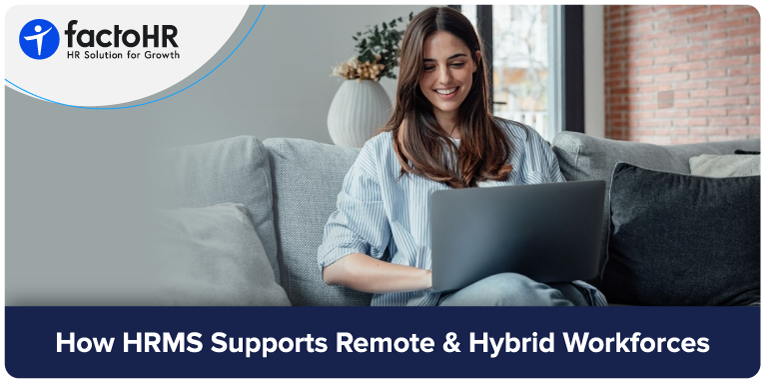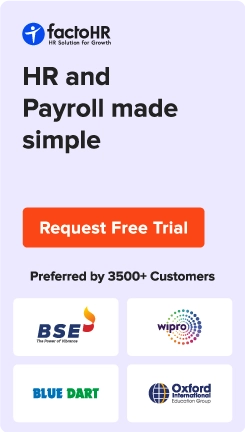How HRMS Supports Remote & Hybrid Workforces in 2025

Table of Contents
Can HR professionals ensure every employee feels included and connected with remote team members and those in the office? HR professionals can implement various practices to help remote employees feel like they are part of their team. However, an organization faces various challenges when managing a remote and hybrid workforce, such as a lack of communication and managing diverse teams. This is where the cloud-based Human Resource Management System (HRMS) or HR software for remote teams comes into the picture.
Remote employees work outside conventional office settings, meaning they carry out their tasks away from the company’s physical workspace. Hybrid employees have a combination work setup, working in the office at times and remotely, often from home, at other times. The COVID-19 pandemic led to the emergence of remote and hybrid work models. Advancements in technology and an increase in demand for work flexibility for work-life balance are also some of the examples. This article focuses on how HRMS for remote and hybrid workforces helps organizations manage and solve various challenges.
How does HRMS Support the Remote and Hybrid Workforces?
HRMS for remote and hybrid workforces helps manage the entire HR process, which starts from recruitment to retirement. It supports collaboration between teams and maintains compliance for multiple locations. Below are some ways HRMS can help manage a remote and hybrid workforce.
Centralized Access to HR Operations
Almost every organization faces issues related to communication and maintaining a positive work culture. Remote workers feel disconnected or face work-related difficulties when communicating with team members. Due to a lack of in-person interactions, teams can also have misinterpretations or delays. All of this leads to a decrease in morale and engagement.
HR software for remote teams enables organizations to address challenges by providing centralized access and employee self-service (ESS) portals. Remote and hybrid employees can access and download payslips or apply for leave without involving HR professionals. Also, when the HRMS has performance management and benefits administration centralized, it reduces the need for employees to juggle between multiple platforms. This helps enhance employee experience and increase efficiency by reducing the time spent on some tasks.
Attendance and Time Tracking for Remote Teams
HR professionals face issues related to data accuracy and managing time zone differences. Remote and hybrid work arrangements make it difficult for managers to verify employees’ accurate work hours. Also, the systems used to record work hours may sometimes have technical glitches and lack real-time data.
The HRMS tracking system can help organizations reduce manual data entry and provide accurate time tracking. This helps calculate accurate work hours, and payroll processing becomes easy without any delays. The software can also track which projects every team is working on and maintain transparency between teams. Buddy punching and time theft are some of the issues that are solved through a biometric attendance system.
Seamless Communication and Collaboration
Face-to-face interactions can solve a lot of problems for employees and help get clarifications in case of doubts. But a lack of communication in remote and hybrid work arrangements makes employees feel confused. When employees can’t have informal conversations, it can also lead to poor collaboration between teams.
HR software for a hybrid workforce can help employees stay connected with teams by providing centralized communication platforms and internal chat systems. The software offers features like shared calendars and document sharing to improve collaboration for both remote and hybrid workforces. HR integration with platforms, like Microsoft Teams and Slack, helps with updates and announcements.
Performance Management in Hybrid Settings
Managers and supervisors have less clarity for employees working in a remote and hybrid arrangement. It is difficult for managers to evaluate employees based on their performance. This creates a negative perception of an employee’s performance and hampers the ability to uphold a strong work culture.
HRMS for remote and hybrid workforces helps organizations effectively manage their workforce’s performance. The software can help set goals and track performance, which encourages every employee to be accountable for their work. Regular feedback is possible through an HRMS for a remote workforce, as the data is centralized and transparent. It is an advantage for modern organizations as the software can adapt to flexible and remote work arrangements.
Remote Onboarding and Offboarding
Onboarding new remote employees can be difficult, as they are not available face-to-face for interactions. This can make them feel disconnected from the new organization and company culture. They struggle to make new relationships with colleagues without informal and casual interactions. Also, when employees leave the firm, there is a chance of a data breach or misuse of sensitive data.
HRMS for remote and hybrid workforces simplifies the virtual onboarding process for remote and hybrid employees. It helps by providing virtual welcome messages and IT infrastructure for remote employees. In the virtual setting, employees feel connected with the company’s goals and policies. Video calls and collaboration tools help new employees communicate. The offboarding process in HRMS can help manage asset retrieval and the exit process smoothly.
Leave, Payroll, and Compliance Simplified
It is difficult to maintain accuracy in the leave tracking process, as employees are working remotely or in a hybrid model. Additionally, payroll processing is challenging for multiple states and countries due to their different time zones. Organizations must also maintain compliance with national and international labor laws, which can be complex.
HRMS software helps organizations to simplify payroll processing and leave management. Employees can request leave, and managers can approve or reject it within the system. It calculates tax and processes payroll automatically, which helps with accuracy. Organizations can maintain HR compliance with labor laws and regulations for multiple regions. When these HR processes are made simple, it also increases employee engagement and satisfaction.
Employee Engagement and Wellbeing Monitoring
Organizations find it difficult to measure the productivity and well-being of employees working in a remote arrangement. This situation can lead to communication gaps between managers and team members. Sometimes employees can also experience social isolation, i.e., employees feel disconnected from their teams. This can lead to burnout as employees can have issues with work-life balance.
HRMS for remote and hybrid workforces helps HR professionals with features like built-in survey features and mood analysis. Based on the insights available, it helps them increase employee engagement. The insights help identify employee patterns in aspects, like the reasons for the high absenteeism rate. The analytics identify improvement areas through metrics such as remote employees’ working hours and productivity. This way, employees’ well-being can be tracked and monitored.
Analytics and Reporting
Employees must have access to data for analytics and reporting. Data breaches or cyberattacks are one of the most prominent risks regarding remote work arrangements. This is because their mode of work is mostly through digital platforms. Employees’ total working hours might be difficult to calculate due to a lack of visibility in their performance.
HR reporting helps analyze employee feedback and survey forms to identify areas of improvement. Employees’ productivity and time spent on projects can be tracked to know which areas are affected by the remote work arrangement. Informed decisions can be made in areas like talent management and resource allocation.

Conclusion
Due to its benefits, HRMS for remote and hybrid workforces has become a necessity for almost every organization. These advantages range from data centralization to compliance with labor laws and regulations. The software also helps maintain accuracy in HR-related processes and efficiency for remote workforces.
Since remote and hybrid setups bring unique challenges — including productivity tracking and employee well-being — organizations should evaluate solutions that best address these needs. Exploring India’s best HRMS software list can help you compare leading providers and select a system tailored to support flexible, modern work models.
Grow your business with factoHR today
Focus on the significant decision-making tasks, transfer all your common repetitive HR tasks to factoHR and see the things falling into their place.

© 2025 Copyright factoHR


